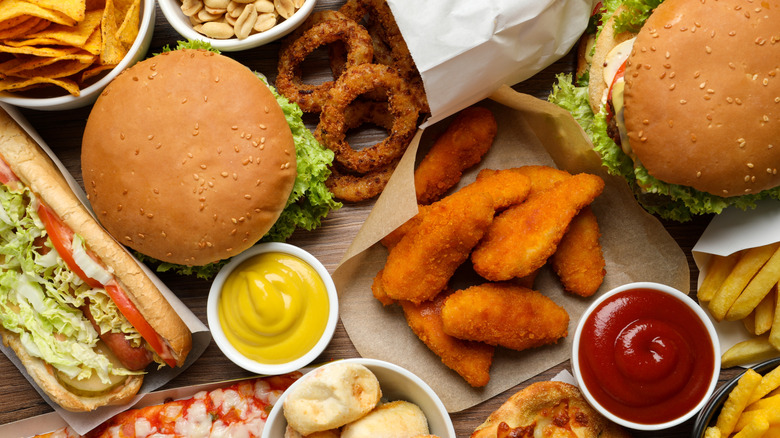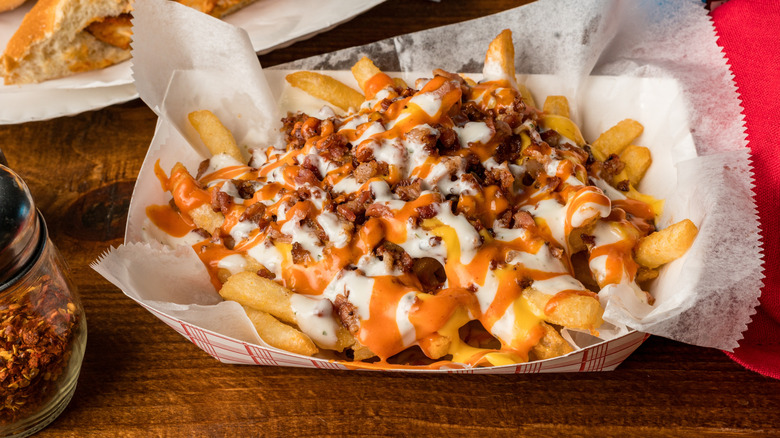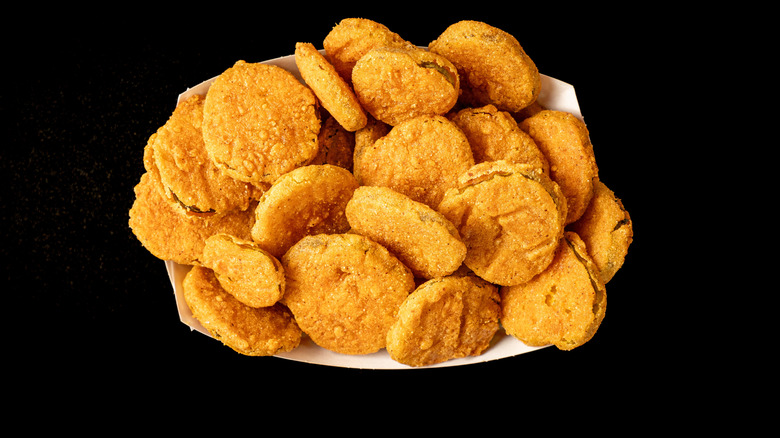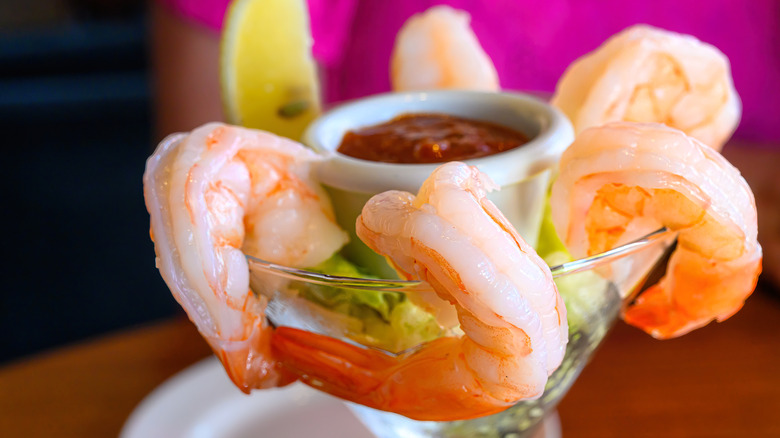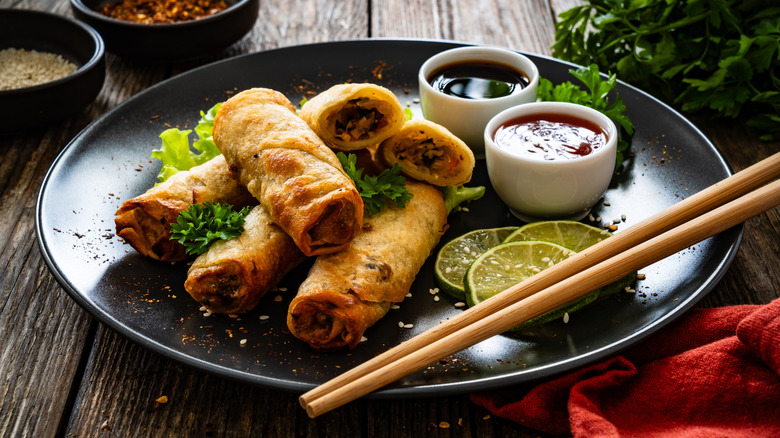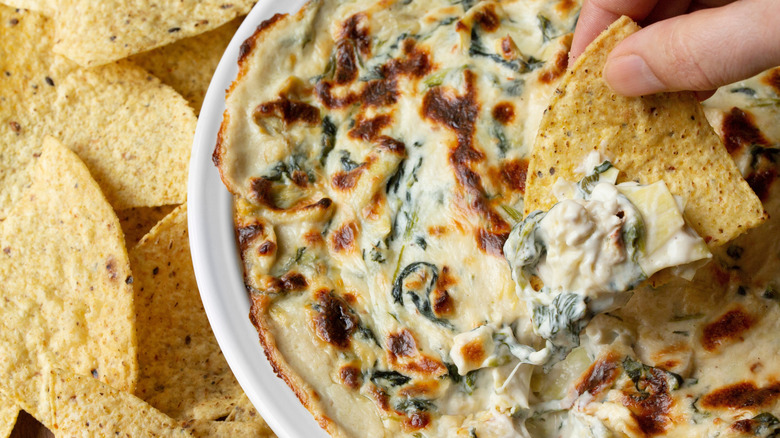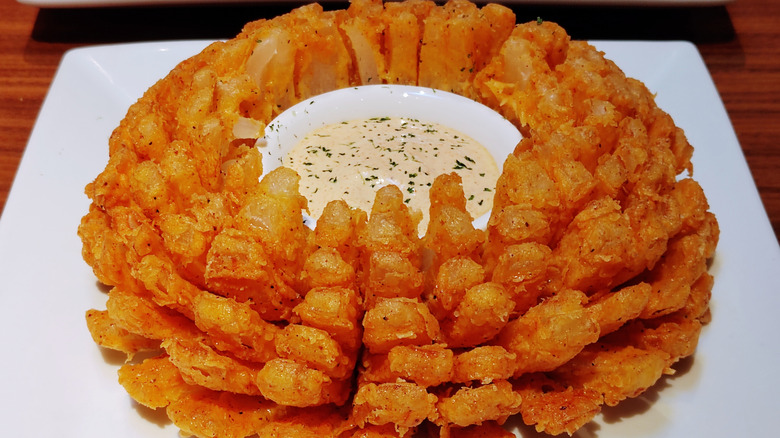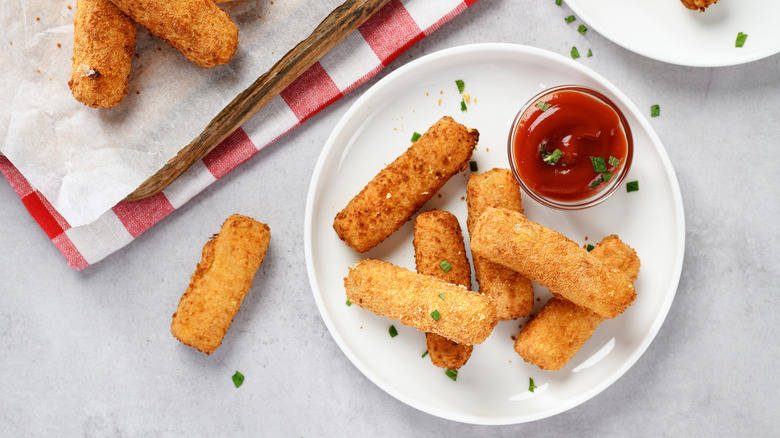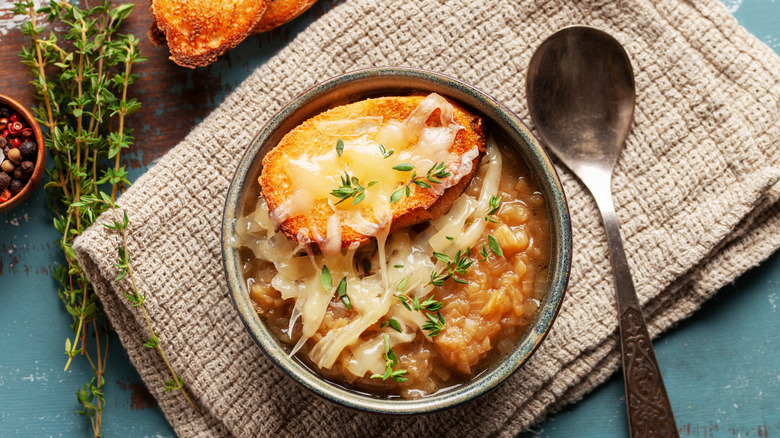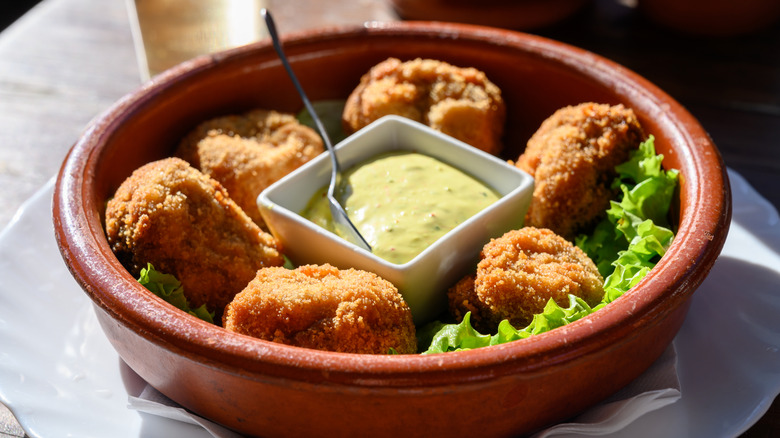12 Chain Restaurant Starters That Desperately Need A Refresh
It's time for a bit of straight talking. There are some chain restaurants out there that are just not cutting it anymore. We would go so far as to say they have been coasting on their reputation and clinging to old, tired menu items.
Take appetizers, for example. These starters are the opening act to a restaurant's menu — the tease show before the main event. But for the most part, chain restaurant appetizers remain uninspired and repetitive. The same cliched presentation, the same limp garnishes, the same predictable tastes and flavors. We know these dishes can do so much better. And more importantly, we can demand better choices.
We get that many of the items on the list evoke a heavy dose of nostalgia. And there's no shame at all in ordering your favorite comfort food. Treat this as more of a friendly nudge to chain restaurants to get with the times. As diners, we are bored with the same old lineup, and all we ask for is a long-overdue upgrade. So settle in and take a closer look with us at the starters we've seen and tasted countless times before, and how they could be healthier, tastier, and way more worth the order.
Loaded fries
When the American Heart Association recommends no more than 13 grams of saturated fat daily, and a single portion of loaded fries can provide significantly more than that in one go, it's probably time to rethink things. Fries alone are already trouble, with sky-high sodium and fat levels. Adding meat, cheese, and bacon to an already unhealthy dish feels like courting trouble.
Secondly, let's face it — loaded fries feel like a bit of an afterthought. Something a chef slapped together with a bunch of leftovers at best. As one Redditor succinctly sums up, "The entire point of fries is to be crispy on the outside and fluffy on the inside [...] How on earth are entire restaurants dedicated to throwing wet meats and sauces on fries??" We agree.
However, many people choose loaded fries, convincing themselves that adding protein like barbecue chicken, chili, or pulled pork somehow makes it a more balanced meal. Spoiler alert: Not a chance, my friend. No matter how fresh and crispy the fries (and we'd like to believe they're not refried in the same sketchy oil that's been bubbling away all day), it's time this dish slid off the menu for good. Instead, we suggest smaller sharing portions and toppings that don't drown the whole dish. Easy ways to elevate would be with roasted garlic, feta, and za'atar, or even a zingy chimichurri. No need to give up on the indulgence. Rather have a reason to want to order it again.
Raw oysters
Up there with caviar and Champagne, a platter of raw oysters on ice conjures up images of candlelit soirées and romantic dinners à deux. So when your average Joe chain restaurant starts putting on the ritz and offering up these shelled delicacies, one has to pause. Now, we're not saying oysters should remain exclusive, but stay with us here. Oysters served in specialized bars, seafood restaurants, or fine dining establishments have (or should have) the proper storage facilities, be handled by trained personnel (ideally a full-time shucker) who have a beady eye out for flaws and signs of spoilage, and will demand a higher quality of produce all around.
When oysters are stored improperly, handled poorly, or exposed to cross-contamination, there is a higher chance of serious food poisoning. Oysters have a remarkably short lifespan, and according to the CDC, raw oysters may carry a bacterium called Vibrio. The scary part is, you can't detect it – not by smell, not by sight, not even by taste. You only find out once it's too late. The only sure way to avoid this is by cooking them.
So if you're a chain restaurant without the right setup, maybe it's best to lay off the raw oysters altogether. Or at the very least, serve them cooked. For everyone's sake. Chargrilled with garlic butter or baked with a hint of spice. Leave the raw stuff to the pros, and get creative with the rest.
Fried pickles
By now, you may have noticed a trend in this listicle. Appetizers that are deep fried, battered, or breaded seem to dominate. Are we finally tired of fried stuff? Have the health warnings started to hit home? Doubtful. But we are here to fight the good fight to eat better and to get restaurants to commit to serving better quality food as well. Take pickles, for instance. Passable on their own (albeit heavy on the sodium levels), but it's rare to sit back with a bowl full of plain pickles and a beer. Now dip these same pickles in a batter and deep-fry to crisp, and suddenly, chain restaurants and fast food joints are sitting up and taking notice.
Once a staple at county and state fairs in the 1980s, pickles moved to mainstream appetizer menus in the early 2010s. Even KFC joined the fried pickle bandwagon. Suddenly, you couldn't walk past a restaurant without being hit by the warm, pungent fug of a deep-fried bunch of pickles. But be warned, these little roundlets can come in at nearly 880 calories a basket. That's a huge amount for one snack. Add to it the vinegar and brine and oil used to fry, and you're in for a trans fat and sodium buffet.
If you still yearn for the crunchy-tangy combo, we get it. But maybe think lighter instead. Tempura-style batter or air-fried versions with a herby yogurt dip help retain the zing and lose the grease.
Shrimp cocktail
Not all chain restaurant appetizers are unhealthy, but some still make this list. Take the ubiquitous shrimp cocktail. A hit since the 1960s, and once a staple on every swanky dinner party, shrimp cocktail still has its loyal fans. However, we are going to call it: Shrimp cocktail has had its time to shine, and now it's time to move on. Yes, we get it. It's that rare unicorn of a healthy app (high in protein, low in fat). But it's also been stuck in a time warp. It's barely evolved, never strayed from its original recipe, and to be honest... we're bored.
Also, how can restaurants charge so much for shrimp cocktail — something so basic that it involves barely any cooking? I mean, anyone can plop a few shrimp in hot water, blanch to retain plumpness, and whip up an easy-peasy cocktail sauce. So to charge (and more importantly, to pay) around $30 for this is simply foolish, we say.
Finally, while shrimp is never served raw, there are still health risks involved. Shrimp, like most seafood, may harbor bacteria if not cleaned and stored properly. The restaurant needs to ensure that the shrimp is kept on ice or refrigerated until ready to consume. So what's the alternative? In the spirit of no more boring appetizers, toss the shrimp in a zesty ceviche sauce instead, or char it on skewers and serve it with chili and lime.
Spring rolls
Let's talk about spring rolls. The kind you spot on nearly every chain appetizer menu, usually served up with some sort of chili (but secretly sugary) dipping sauce and some veggies no one asked for. At a glance, spring rolls seem like the healthier cousin of the even more popular egg roll. Available with a variety of fillings depending on which cuisine is on the menu, spring rolls could be deep-fried or just lightly steamed. The wrappers may be made of rice paper or flour.
But the sad truth is, spring rolls can be surprisingly underwhelming. The filling tends to be less packed in and largely veggie-based. Seasoning is often non-existent, relying on the accompanying sauce to carry through. And the occasional protein rarely adds to the overall flavor. Then there's the wrapper. Too thin and it turns soggy within minutes. Too thick and you end up with a leathery crunch that overshadows everything else. A Reddit thread confirmed our feelings by proclaiming that "Even with the same quality of entrees across different restaurants, getting a spring roll of pure cabbage or something actually decent is always 50/50".
So what would make us care again? Give us bold, out-of-the-box fillings instead. We are dreaming of spiced jackfruit, lemongrass chicken, chili mushrooms, or slow-cooked pork. Wrap them up tight, and a quick pan-sear would do the trick beautifully. Pair with a sauce that doesn't spike our sugar levels, and we promise, we would be lining up.
Spinach and artichoke dip
You read spinach and maybe artichoke, and you naturally think that this sounds like a perfectly light, good-for-you way to entertain your tastebuds until the main course arrives. Some greens to start things off sounds ideal. What you're conveniently forgetting is that the actual star of the show in any spinach dip is not the spinach or even the added artichokes. It's cream cheese. And not just a polite amount. There's a significant amount of cream cheese used in such dips. Think brick-sized instead of spoonfuls. There might even be some sour cream or mayonnaise added for extra 'fluffiness,' and there will definitely be more cheddar and Parmesan sprinkled and melted atop the dish. The result, unsurprisingly, is a dish that can creep past 1,000 calories. Mind you, this is before you even pick your carb of choice for scooping – bread, tortilla chips, or crostini being the usual suspects.
The worst part? It doesn't even deliver a meal worth the tummy space. It's still very much a starter, and you're still going to order a main (and probably dessert). So, what would we like to see instead? Maybe a light whipped feta dip with herbs and charred scallions, or a smoky eggplant spread with warm pita. Hummus and raw veggie sticks would do the trick, as well. They're all way more flavor-forward, and far less deceptive.
Cheeseburger sliders
There's nothing quite like a cheeseburger, right? With its mouthwatering combination of cheese, lettuce, onions, and tomatoes topped by a juicy burger patty, what's not to love? Enter the slider — the smaller, more manageable sibling. After all the talk we hear about cheeseburgers being a calorie bomb, these bite-sized versions feel like a smarter choice. After all, it's the same deliciousness packed into a smaller parcel. That's where we get things wrong, unfortunately.
As a Redditor wisely asked, "Why eat lots of small burgers instead of one regular-sized one?" It's a valid point, especially when you consider that a typical cheeseburger slider order has three sliders for a whopping 1270 calories. So there's that. Some might argue that ordering sliders (that usually come in sets of three assorted varieties) allows you to try different kinds while in essence eating less food. Or it could be that restaurants cottoned on to the fact that mini burgers translate into less bread and less meat but still high prices.
But we are not giving up on these little treats as yet. What we propose instead is lightening and brightening up the choices available. Think lean protein like chicken or turkey, or even grass-fed beef for a cleaner option. Upgrade the bun to something artisanal, such as sourdough, brioche, or even a deviled egg slider bun for a keto-friendly alternative. Top it off with a herby yogurt sauce, and roasted or pickled veggies. Who wouldn't want some of these?
Blooming onion
A monster of an appetizer, the onion is peeled back to resemble a flower, and the 'petals' are then deep-fried. While visually impressive, it's a nutritional minefield. With around 1950 calories per portion and sodium levels that are more than twice the daily limit for a healthy adult, it's easily one of the least healthy appetizers on a menu.
Let's be honest, though, the blooming onion has always been tasty. First created in the 1980s, blooming onions came into fashion in the 1990s as a fun twist on fried onion rings. Something different to order, but basically the same old, same old with a much larger portion that was meant to share. In this day and age, with more focus on healthy living, this dish feels wildly out of place.
But all is not lost. If you're still craving that crunchy onion-y bite, opt for a smaller, more manageable portion. Go full circle and revisit the classic onion ring, but this time made with a lighter batter and baked or air-fried instead of deep-fried. Or better yet, try roasted onion petals seasoned with smoked paprika, garlic, and herbs, served with a tangy dip, for a change.
Mozzarella sticks
It is a classic combination: mozzarella that has been batter-coated, deep-fried, and served with marinara sauce. Comfort food at its finest, some might add. Mozzarella sticks turn up on almost every chain restaurant menu, but peel back the nostalgia, and you are left with several worrying factors.
The type of cheese served in many chain restaurants is usually the same bland, overly processed variety. Most of the taste comes from the accompanying sauce, which may be marinara or Alfredo. Boring is the term that comes to mind. Next comes the high calorie count, at approximately 900 calories per serving, but this figure can go all the way to 1800 or even over 2000 calories in some places. And let's not even get started on the sodium and fat levels. If this isn't bad enough, these sticks usually contain a whole bunch of allergens like milk, wheat, soy, and eggs. If you are sensitive to any of these, then you'll need to stay away.
If, despite this information, you still crave some mozzarella sticks, do your body a favor and limit what you eat to just a couple of sticks. Alternatively, you could try veggie sticks along with hummus instead, or some tempura-fried vegetables. What's even the point then? Okay, what about baked mozzarella bites with a range of sauces or even a moreish tomato jam? Grilled halloumi with chimichurri also ticks those cheesy comfort boxes with so much more character.
Soup
A bowl of soup seems like a pretty safe choice if you're trying to make healthier choices when eating out. And compared to the usual suspects with "fried" in their name, you wouldn't be wrong. Most chains offer at least one soup on their menu, albeit pretty traditional varieties.
Apart from the fact that soups tend to be quite filling, they don't always deliver on the expected dose of healthy nutrients that you might expect. Soups usually come packed with a hefty dose of sodium. A standard 12-ounce bowl can contain over 1,000 milligrams of salt, which is more than half your recommended daily intake in one go. Then there's the matter of quality. Take the French onion soup. A bistro classic for sure, but rarely more than a soggy mess with rubbery, melted cheese. Much of the blame lies in the fact that traditional French onion soup — the good kind — takes hours to simmer over a stove. Time that most chain restaurants rarely devote to any dish, let alone the soup of the day. Cream-based vegetable soups aren't much better, delivering sky-high calorie counts and saturated fat levels without offering much in return.
So what's the fix? Look for broth-based soups with whole ingredients such as lentils, beans, leafy greens, or lean protein like shredded chicken or tofu. Miso soup, a clear veggie broth, or a lightly spiced tomato-based option are also great additions to any menu that fill you up without the regret.
Loaded potato skins
Melted cheese, bacon, and green onions on a potato bed and served with some sour cream sounds like a delicious combination, probably why they have been a restaurant staple for decades. However, their popularity has been on the wane.
There could be several reasons for this. Many chain restaurants use pre-made potato skins that have been reheated rather than freshly baked ones, and that is never a good thing. Add to that a heavy-handed dose of cheese and bacon, and you're left with a greasy, sodium-loaded starter that can kill your appetite. In today's health-conscious and fitness-obsessed world, their high calorie, fat, and sodium levels make them prime contenders for the list of unhealthiest starters. And finally, we are pretty sure they have fallen out of favor because of their inherent unattractive look — a strict no-no for the Instagram generation.
To help resurrect them, we suggest a modern glow-up. Play around with the type of potato used, and offer roasted sweet potato halves topped with a bit of crumbled goat cheese and some roasted nuts. Or use small baby potatoes, smashed and crisped up and grilled with sharp cheddar and bacon bits for a bite-sized treat.
Battered mushrooms
Batter-fried mushrooms have been a staple on chain restaurant menus for a while now. With mushrooms sometimes being touted as a healthier, plant-based alternative to meat, it's easy to see why they've become so popular. However, we do have a few pet peeves when it comes to certain mushroom dishes.
Battered mushrooms, in particular, are rarely a culinary masterpiece. Mushrooms are naturally full of water, and in order to prevent a soggy, shriveled plate full, a degree of patience and care has to be taken while cooking them. Add batter and deep-frying to the mix, and it becomes even trickier. Deep-frying, as you can imagine, piles on the calories and saturated fats, which cancels out the health halo mushrooms started with.
Want a smarter take? Try grilled portobellos brushed with olive oil and herbs as a hearty appetizer option. Alternatively, crispy roasted oyster mushrooms with a squeeze of lemon and a pinch of sea salt offers spades of earthy, umami flavor along with that all-important crunch.
